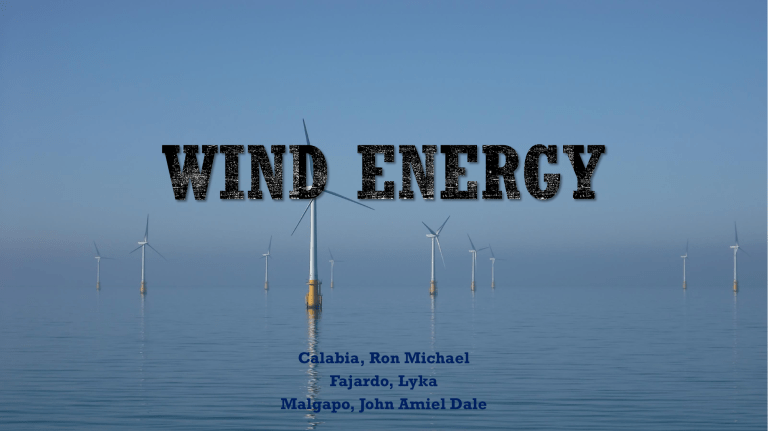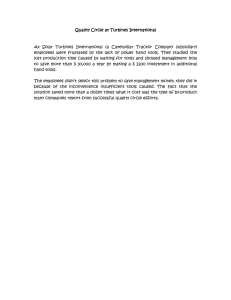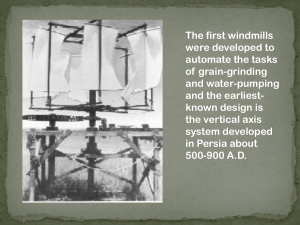
Calabia, Ron Michael Fajardo, Lyka Malgapo, John Amiel Dale ▪ Wind energy (or wind power) refers to the process of creating electricity using air flows that occur naturally in the earth’s atmosphere. Modern wind turbines are used to capture kinetic energy from the wind and generate electricity. ▪ When the wind blows past a wind turbine, its blades capture the wind’s kinetic energy and rotate, turning it into mechanical energy. This rotation turns an internal shaft connected to a gearbox, which increases the speed of rotation by a factor of 100. That spins a generator that produces electricity. ▪ A typical modern turbine will start to generate electricity when wind speeds reach six to nine miles per hour (mph), known as the cut-in speed. Turbines will shut down if the wind is blowing too hard (roughly 55 miles an hour) to prevent equipment damage. ▪ Utility-scale wind ▪ Distributed or small wind ▪ Offshore wind ▪ Utility-scale wind:Wind turbines that range in size from 100 kilowatts to several megawatts, where the electricity is delivered to the power grid and distributed to the end user by electric utilities or power system operators. ▪ Distributed or "small" wind: Single small wind turbines below 100 kilowatts that are used to directly power a home, farm or small business and are not connected to the grid. ▪ Offshore wind: Wind turbines that are erected in large bodies of water, usually on the continental shelf. Offshore wind turbines are larger than land-based turbines and can generate more power. ▪ Windmills generate mechanical energy, but they do not generate electricity. In contrast, modern wind turbines are highly evolved machines with more than 8,000 parts that harness wind's kinetic energy and convert it into electricity.` ▪ Unlimited, Free, Renewable Resource ▪ Economic Value ▪ Maintenance Cost ▪ Non-polluting Way To Generate Electricity ▪ Harmlessly Generate Electricity From Wind Passing By ▪ Ability To Place Turbines Wherever Necessary Wind is a natural occurrence and harvesting the kinetic energy of wind doesn't affect currents or wind cycles in any way. Wind creates jobs. The U.S. wind sector employed more than 100,000 workers in 2016, and wind turbine technician is one of the fastestgrowing American jobs of the decade. According to the Wind Vision Report, wind has the potential to support more than 600,000 jobs in manufacturing, installation, maintenance, and supporting services by 2050. Land-based utility-scale wind is one of the lowest-priced energy sources available today, costing between two and six cents per kilowatt-hour, depending on the wind resource and the particular project’s financing. Because the electricity from wind farms is sold at a fixed price over a long period of time (e.g. 20+ years) and its fuel is free, wind energy mitigates the price uncertainty that fuel costs add to traditional sources of energy. Wind energy is far more ecofriendly than the burning of fossil fuels for electricity. Currently, the United States, along with other countries, remains dependent on fossil fuels imported from unstable and unreliable nations. electricity to make wind like a fan wind turbines use wind to make electricity. Wind turns the propellerlike blades of a turbine around a rotor, which spins a generator, which creates electricity. After performing research and finding areas that have adequate wind, experts may place the turbines in desired areas. Wind is actually a form of solar energy. Winds are caused by the heating of the atmosphere by the sun, the rotation of the Earth, and the Earth's surface irregularities. For as long as the sun shines and the wind blows, the energy produced can be harnessed to send power across the grid. ▪ High Initial Cost ▪ Technology Immaturity ▪ Aesthetic Impact ▪ Wildlife ▪ Remoteness Of Location ▪ Noise ▪ Safety At Sea Constructing turbines and wind facilities is extremely expensive. High cost of energy can, in part, be addressed directly with technology innovations that increase reliability and energy output and lower system capital expenses. Many people are concerned with the visual effects that wind turbines have on the beautiful scenery of nature. They believe that giant wind turbines distract viewers from the beautiful surroundings. Wind turbines may be dangerous to flying animals. Many birds and bats have been killed by flying into the rotors. Experts are now conducting research to learn more about the effects that wind turbines have on marine habitats. Although this may be an advantage (placing wind turbines in desolate areas, far away from people), it may also be a disadvantage. The cost of travel and maintenance on the turbines increases and is time consuming. Offshore wind turbines require boats and can be dangerous to manage. Some wind turbines tend to generate a lot of noise which can be unpleasant. In the darkness/at night it may be difficult for incoming boats to see wind turbines thus leading to collisions. DAKOTA SOUTH



